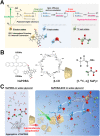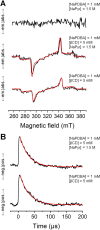Triplet dynamic nuclear polarization of pyruvate via supramolecular chemistry
- PMID: 38075643
- PMCID: PMC10699585
- DOI: 10.1039/d3sc04123a
Triplet dynamic nuclear polarization of pyruvate via supramolecular chemistry
Abstract
Dynamic nuclear polarization (DNP) significantly improves the sensitivity of magnetic resonance imaging, and its most important medical application is cancer diagnosis via hyperpolarized 13C-labeled pyruvate. Unlike cryogenic DNP, triplet-DNP uses photoexcited triplet electrons under mild conditions. However, triplet-DNP of pyruvate has not been observed because of incompatibility of the hydrophobic polarizing agent with hydrophilic pyruvate. This work demonstrates that supramolecular complexation with β-cyclodextrin can disperse 4,4'-(pentacene-6,13-diyl)dibenzoate (NaPDBA), a pentacene derivative with hydrophilic substituents, even in the presence of high sodium pyruvate concentrations. The polarization of photoexcited triplet electron spins in NaPDBA was transferred to the 13C spins of sodium pyruvate via triplet-DNP of 1H spins in water and 1H-to-13C cross-polarization. This provides an important step toward the widespread use of ultra-sensitive MRI for cancer diagnosis.
This journal is © The Royal Society of Chemistry.
Conflict of interest statement
There are no conflicts to declare.
Figures





References
LinkOut - more resources
Full Text Sources
Other Literature Sources

